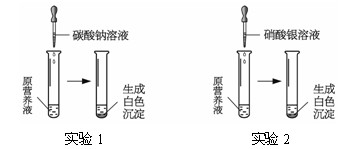问题
实验题
现有一种无色的营养液,可能由KNO3、Ca(NO3)2、K2CO3、KCl中的一种或几种物质组成,为探究其成分,某同学设计并完成了如下图所示的实验。

根据以上实验,请你进行有关推断。
①由实验1可确定原营养液中一定没有的物质是________;
②根据实验1、实验2推测原营养液的组成可能有_____种情况;
③若测得原营养液中K+和Cl-的数目之比为1:1,则原营养液的组成中的溶质是________________。
答案
①K2CO3
②2
③KCl、Ca(NO3)2
